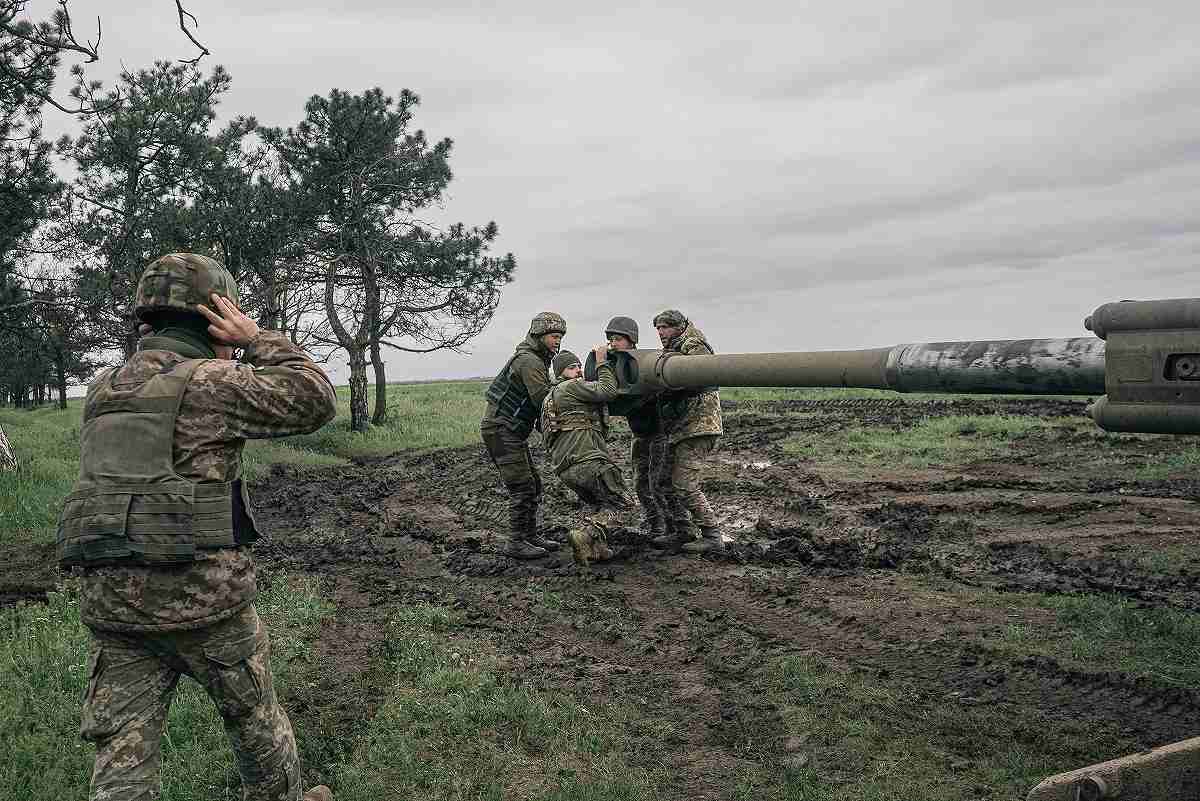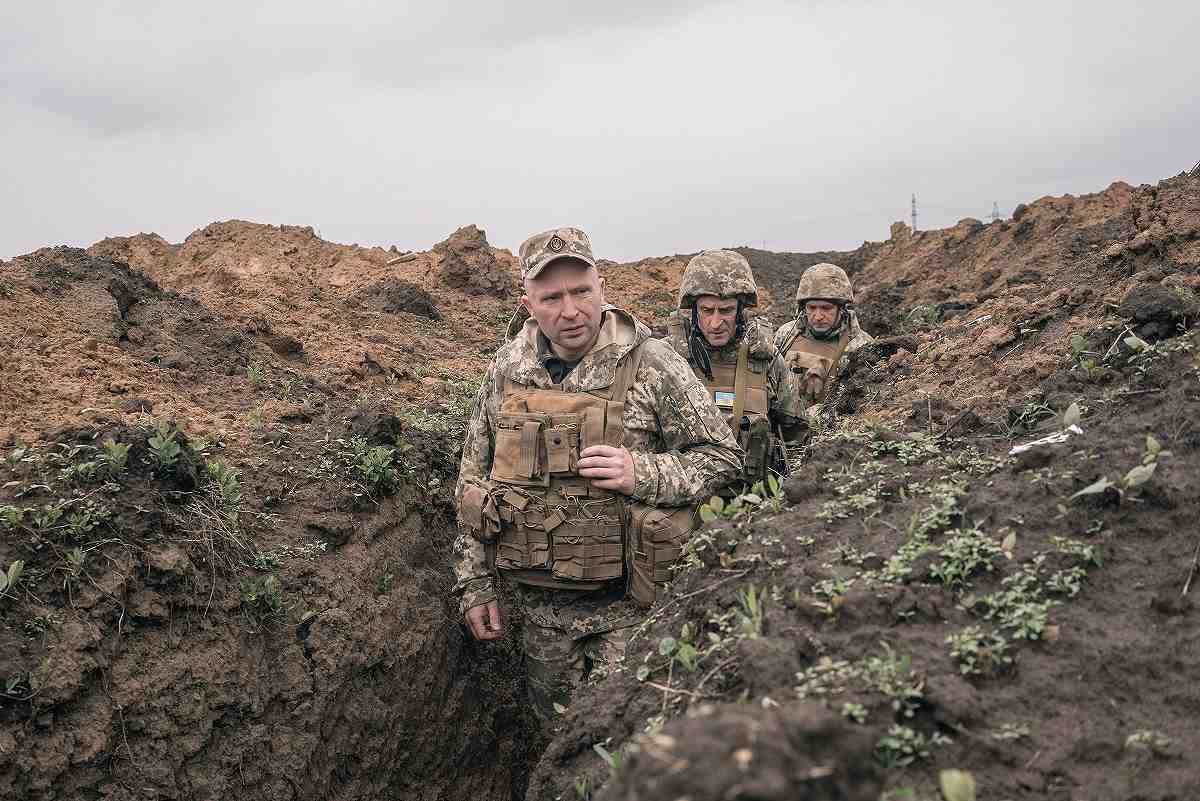
Members of the 406th Separate Artillery Brigade adjust the position of a howitzer.
17:06 JST, May 20, 2023
KHERSON, Ukraine – Every night in Ukraine’s southern Kherson region, soldiers file into small dinghies to cross the Dnieper River and bring the battle closer to their Russian enemy.
The sprawling waterway, with Russian and Ukrainian forces posted on opposite banks, is the war’s most immovable front, a barrier to transporting troops and supplies. But as Kyiv readies a highly-anticipated counteroffensive, an attack on the river’s east bank might be the one place where the Russians could be caught by surprise.
“In the history of war and military art, there are many examples of crossing a water barrier – a river landing or a sea landing,” Brig. Gen. Mykhaylo Drapatyy, Ukraine’s commander of the operational group of Kherson troops, said. “Certain conditions are being created so that the Dnieper River barrier will not only hinder us but also help us to accomplish our task. If the conditions are right, we will move forward.”
Intrigue about where Ukraine’s counterattack will take place in the coming weeks has focused on the Zaporizhzhia region, where Kyiv’s forces conducting an overland assault would likely try to expel the Russian occupiers from the city of Melitopol, and break the so-called land bridge connecting Russia to occupied Crimea, where Russia has several strategic military bases.
Ukraine might also continue counterattacking in the east, where it has recently made gains around the long-beleaguered city of Bakhmut.
Those scenarios are more likely, but Ukrainians also have been quietly testing their ability to push across the Dnieper and training units in how to conduct a possible river landing.
Ukraine used the tactic of surprise to its advantage in a sweeping, fast counteroffensive last fall, which liberated nearly the entire northeast Kharkiv region within a week. Like in the Kherson region now, the Russians left the weakest grouping of forces in Kharkiv at the time, expecting the Ukrainians to attack somewhere else.
A cross-river attack could be just as unexpected and also yield big territorial gains. There are approximately 40,000 Russian troops in the Kherson region on the river’s east bank, Drapatyy said. And regaining control there would similarly break the land corridor and put Ukrainian forces near the Crimean border – a goal for Kyiv, which has vowed to reclaim the peninsula illegally annexed by Moscow in 2014.
Ukrainian Special Operations forces have already crossed over to the east side of the river for raids along the shore, Drapatyy said, but the Ukrainians do not have any stable posts there yet. The Russian positions are some three miles inland from the riverbank, and the Ukrainians would need to push them back at least another six miles to get the city of Kherson, located on the west side and under the control of Ukrainian forces, out of artillery range.
“We are trying not only to show our presence but also to make the enemy nervous by active actions in those areas,” Drapatyy said.
Russian forces retreated from the west bank of the Dnieper River in November, when Ukrainian forces got within strike range of the bridge crossings, threatening to trap the occupying troops who would have no way of getting to their strongholds on the other side. The Russians opted to pull back their forces to the east bank and blow up any bridges behind them. That left the Ukrainians without an obvious way across to continue the assault.
Now, artillery shells and drones loaded with explosives fly across the river daily, the battle settling into one of distance while Ukrainian assault units train twice per week for operations to cross the Dnieper both by boat and using a pontoon-bridge, Drapatyy said. Ukraine also has started constructing barges that could be used to transport heavy weaponry across the river.
“Maybe I’m an optimist, but I do believe in the time that will come when we need to set up logistics,” Drapatyy said. “We will not be able to solve the issue with just one or two or three pontoon bridges, so we will use everything we can, including army aviation, and we are working on this issue and preparing for it.”
Challenges remain: The Ukrainians don’t yet have a bridgehead, and any attempt at one would immediately be targeted by Russian artillery.
“And the Russians mined everything on the other side,” said Col. Roman Kostenko, a member of Ukraine’s national parliament who is part of a unit that works with Special Operations Forces. “The water is mined, and the shore is mined.”
“You’re going to get killed right away trying to cross,” Kostenko said. “There would need to be a logistical reason for it all. Some 20 or 30 people could quietly take some piece of territory that is 100 meters, but then artillery will bury them within 15 minutes. If you’re going to do it, then you need to do it for something – a bridgehead and then to create a logistics chain for an accumulation of troops.”
But the Ukrainians’ first priority is reclaiming the islands between the riverbanks, where the main fight is taking place now, because it could give Kyiv’s forces a closer launch point to cross to the Dnieper’s left coast. Drapatyy said they are “90 percent” under Ukrainian control, “if not with our physical presence, then under visual and fire control.”
“In the future, this may be one of the areas for a bridgehead where we will accumulate forces,” he said. “And perhaps if we divert attention to another front, we will be successful.”
On Velykyi Potomkin, the largest of the islands and where the river splits south of Kherson city, Russian forces are on the southern edges while Ukrainians are posted on the northern side. Now-abandoned vacation cottages on the shore have wooden piers. Soldiers approaching in dinghies cut the motor as they get closer, quietly docking and then scrambling inside.
“You move quickly until the enemy drone sees you or until the mortar fire kills you,” said Andrii, the commander of a unit that has been part of the battles on Velykyi Potomkin. The Post agreed to identify Andrii only by his first name because he was not authorized to speak about his operations.
“You run to the houses,” Andrii said. “If they start shooting, you run to the next one.”
Andrii said he “thought we were going to die” the first time he and his men got into their boats and crossed the river last winter. The Ukrainians got lucky, he said, and landed on a spot of the island where the Russians weren’t at the time. When the Russians finally got there, the Ukrainians ambushed them – and then the reinforcements, too.
“From that small patch, where we first established ourselves, we built up little by little,” he said. “It’s been at least three months, and we’re making progress.”
The terrain through the middle of the island is impassable, Andrii said, so soldiers move along the shore, from house to house. The Russians rarely leave their bases, but the Ukrainians have been on the attack recently.
“Until you enter the house, you don’t know if they’re in there,” he said. “You might walk in and a machine gun is already pointed at you.”
Russian military bloggers late last month started raising alarm about Ukrainian forces creeping up on the shore of the Dnieper’s left bank. Small commercial drones regularly drop explosives, spikes and mines on the 2 miles of road between where the Antonovsky Bridge used to meet the left bank and where the Oleshky bridge begins. The goal is to make the road unusable for vehicles especially – another way of pushing the Russians back from the shoreline because they wouldn’t be able to evacuate any dead or wounded or resupply forces at the river’s edge.
Drapatyy has noticed the Russians recently fortifying their deeper defenses, planting more mines and increasing the frequency of reconnaissance drones they sent flying over to the right side. He said he can hear panic when he listens to their intercepted conversations.
“They are worried,” he said, “that we are preparing for active actions in our direction. All the more reason why we have no right not to prepare.”

Brigadier General Mykhaylo Drapatty walks through a trench in Kherson region in April 2023.
"News Services" POPULAR ARTICLE
-

American Playwright Jeremy O. Harris Arrested in Japan on Alleged Drug Smuggling
-

Taiwan President Shows Support for Japan in China Dispute with Sushi Lunch
-

Japan’s Nikkei Stock Average as JGB Yields, Yen Rise on Rate-Hike Bets
-

Japan’s Nikkei Stock Average Licks Wounds after Selloff Sparked by BOJ Hike Bets (UPDATE 1)
-

Japanese Bond Yields Zoom, Stocks Slide as Rate Hike Looms
JN ACCESS RANKING
-

Japan’s Hopes for Seafood Exports Shot Down in China Spat
-

Keidanren Chairman Yoshinobu Tsutsui Visits Kashiwazaki-Kariwa Nuclear Power Plant; Inspects New Emergency Safety System
-

Japan to Charge Foreigners More for Residence Permits, Looking to Align with Western Countries
-

Japan Exports Rise in October as Slump in U.S. Sales Eases
-

Govt Aims to Expand NISA Program Lineup, Abolish Age Restriction



























